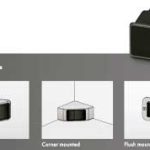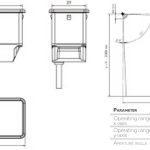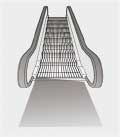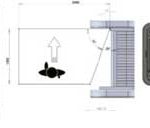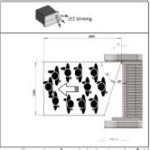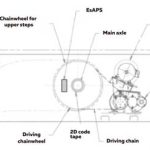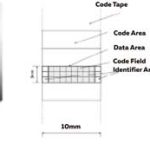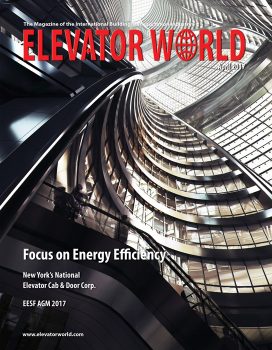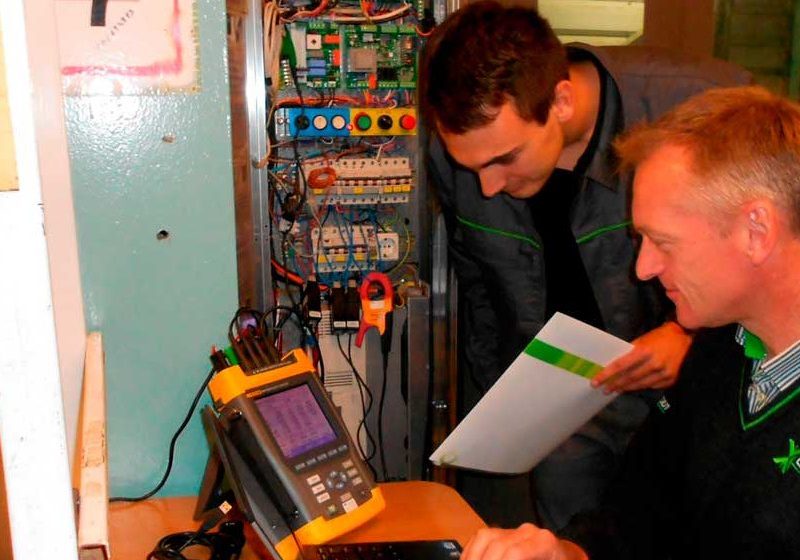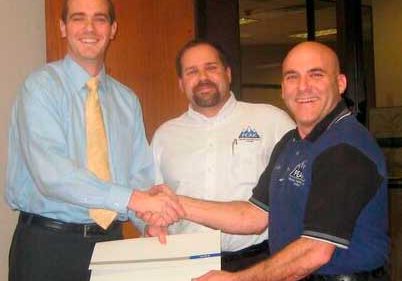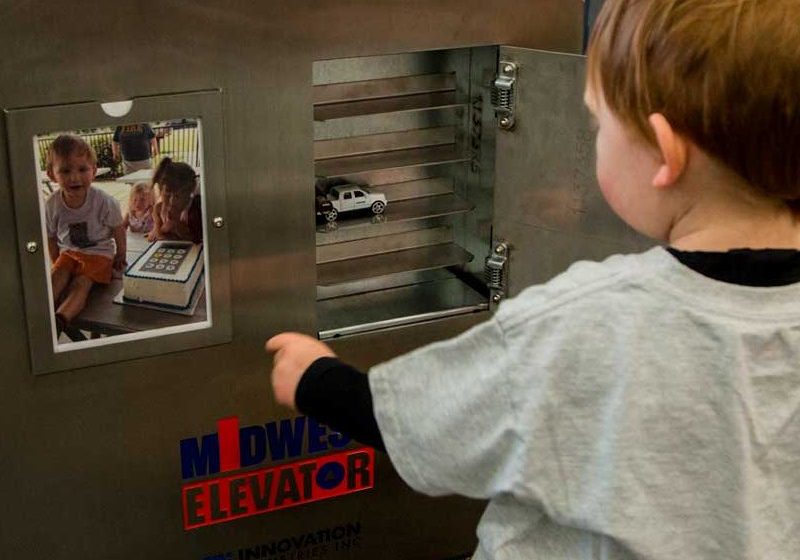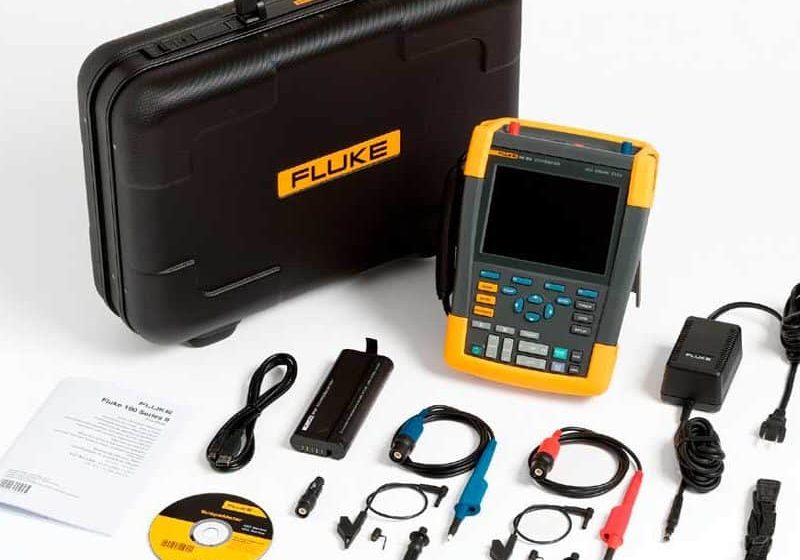New technologies promise a new standard of escalator efficiency, energy savings, safety and comfort.
by Christian-Erik Thoeny and Ruan WeiMin
This paper was presented at  Madrid 2016, the International Congress on Vertical Transportation Technologies, and first published in IAEE book Elevator Technology 21, edited by A. Lustig. It is a reprint with permission from the International Association of Elevator Engineers
Madrid 2016, the International Congress on Vertical Transportation Technologies, and first published in IAEE book Elevator Technology 21, edited by A. Lustig. It is a reprint with permission from the International Association of Elevator Engineers  (website: www.elevcon.com).
(website: www.elevcon.com).
Escalators are an important integrant of infrastructure. To save energy, the speed of escalators is reduced, or the movement is stopped during off-peak times. In such cases, the reliable detection of passengers intending to use the escalator is evident. A revolutionary time-of-flight- (TOF)-based sensor solution, touchless and wear free, ensures reliable detection of persons, regardless of the clothes worn. In addition, the usage of a TOF technology based on the TOFstart sensor enables the handling of cross-traffic or even crowd monitoring, which increases efficiency and prevents dangerous situations.
1. Introduction
Escalators play an essential role in the mass movement of people. This role is continuously increasing with the growth in public buildings, shopping malls and transportation facilities, due to the ongoing urbanization in cities and agglomerations.
Within the space of 20 years, the urban/rural balance will have fundamentally changed, from 45% of people living in cities (1998) to 55% (Figure 1) living in urban areas in 2018. This process is set to continue for the foreseeable future.
It is obvious that this change requires significant improvements with regards to energy efficiency, monitoring, safety, performance and accurate control of all types of machinery involved in people movement. This is especially true for escalators, which move masses of people every day. For this reason, elevator and escalator manufacturers are investing significantly in R&D.
Sensors are the omnipresent prerequisite and information basis for every control function. On the one hand, the number of machines continuously increases, and on the other, the performance of such machinery also needs to be improved dramatically. As a consequence, the demand for sensors is growing faster than most other components in the industry are.
The total market for sensors, covering everything from mechanical to radar types, is set to grow soon to a magnitude of EUR200 billion (US$213.5 billion).
The growth in optoelectronic-based sensors within this market is overproportionate. In 2006, it occupied about 25%; in 2016, the figure was more than 30%.
One important driver in the growth of optic-based sensors is certainly the significantly increased level of intelligence involved. Contrary to other methods, these sensors provide multi-axis data. This covers much more (condensed) information for intelligent control and monitoring of machinery.
Escalators, whether they are single installations or combined multilevel clusters (Figure 3), involve a lot of control and monitoring functions.
The end user can save a lot of energy and reap the greatest benefits from his people-movement machinery when the intelligence of the escalator control is of the latest, state-of-the-art type.
CEDES, together with a major escalator supplier, has developed a new generation of controls that enables another level of efficiency and energy savings.
2. Escalator Start and Stop Sensor TOF/EsPDS
The latest state-of-the-art escalator needs to be started and stopped in such a way that the least amount of energy is used, while still providing a performance that generates the highest possible yield. This can only be done by sufficient and intelligent data provided by intelligent sensors. CEDES’ compact, disruptive TOF multi-axis sensor, the TOF/EsPDS (Figure 4), delivers such intelligence at the required frame rate.
The TOF/EsPDS sensor emits modulated near-infrared light (wavelength of 850 or 940 nm), which is reflected by an object. The object can be either a human, or a fixed post or rail. As it is not merely a single beam, but rather many beams covering a defined area, an intelligent calculation can be done. In effect, a “virtual carpet” is spread out in a defined way in front of the escalator.
The sensor (Figure 5) is compact (52 X 44 X 34 mm) and fits every suitable mounting location on the escalator. The detection area is versatile and big enough to cover the space needed to handle the passenger traffic adequately.
2.1. TOF/EsPDS Starting Function
The TOF/EsPDS detects intending passengers approaching an escalator. It starts the energy-saving sleeping escalator and speeds it up in time for them to step comfortably and safely aboard. After a specified time, the escalator goes into the sleeping mode again.
Fixed obstacles, such as rails and posts, can be simply blanked out in the calibrating process. The active area (Figure 6) is thus clearly defined, and the function is limited to it.
Due to the multi-axis data volume, the start function is more intelligent than just providing a start and stop. Cross-traffic (people walking by and continuously triggering the escalator) detracts greatly from the escalator’s efficiency. The TOF/EsPDS is able to detect people’s walking vector, meaning it can “see” whether the potential escalator passenger intends to step on it or not. Magic? No, the sensor utilizes many beams to detect the dynamic position and, therefore, the direction, of the walking person (Figure 7).
The active areas (Figure 7) are defined, and some can even be adjusted following installation, providing a maximum of flexibility.
2.2. TOF/EsPDS Crowd Monitoring and Stop Function
Have you ever been in a dangerous situation where you just left the escalator with your luggage, only to be trapped in a traffic-jamming crowd of people? The escalator doesn’t stop moving and continues to transport more and more people with their suitcases and sports equipment, such as skis. Imagine if nobody presses the emergency button, or it is too late to do so. Consider what could happen to small children in this jam.
The same sensor, mounted at the end of the escalator (Figure 8), detects that the crowd is not moving anymore and safely slows down and stops the escalator in time. This ensures nobody is hurt or pushed uncomfortably. This function increases the safety and comfort of an escalator.
If objects move away from the escalator in a normal way, the output will not be triggered.
If the number of people in the detection field increases, and people flow slows down (congestion), a defined output will be triggered (pulsed).
Even a slowdown of the traffic can be detected, triggering a slowdown of the escalator itself.
The new TOF technology and the way the TOF/EsPDS is built into the system provide a unique level of compactness. A lot of functionality is integrated into the imager chip, which is the base for a limited number of components. This means the cost of the system is very low in comparative terms, unequaled considering its highly intelligent functionality.
There is scope to realize increased functionality. Such multibeam sensors can also be used to detect whether the escalator is empty, sending the system into a sleeping mode safely and much earlier. Energy efficiency is again increased. Furthermore, additional preventative maintenance and safety functions can be integrated by using such sensors. Severe accidents can happen when escalator steps are missing. Such sensor systems can detect these potentially fatal situations.
All in all, such new technologies bring escalators a new standard of efficiency, energy savings, safety and comfort.
2.3. TOF/EsPDS Children Detection
As stated in section 2.2, a TOF/EsPDS sensor is installed at the exit end of the escalator to perform crowd detection. At the exit end, the hand belt goes into the main structure of the escalator. Having children playing in this area (Figure 9) brings up a considerable hazard for fingers and hands to be squeezed among the moving hand belt and the escalator structure.
TOF/EsPDS calculates distance information for each pixel in the detection field. Children playing in very close proximity to the sensor (where the entry of the hand belt into the escalator structure is also located) can be detected, and a respective output triggered. Using this output, an acoustic warning, slowdown and/or stop of the escalator movement can be performed.
3. Escalator Safe Closed Loop Control
3.1. Requirements of Standards
According to EN 115-1: 2008 + A1: 2010 and GB 16899-2011, escalators must be designed with electric safety devices/functions for excessive speed and unintentional reversal of the direction of travel. Stall (a loss in velocity) or reversal running monitoring may happen when the driving-device motor and reduction gearbox suddenly lose power, the driving chain breaks/displaces or the escalator slides in acceleration under the gravity caused by passengers on it.
3.2. Control of the Driveshaft
The ultimate reliability for a closed-loop control is having the position readings of the sensor directly at the chain wheel, which is form-locking connected to the driving chain. No transmission slip has an impact on the result, and the controlled variable is directly used as the actuating variable for the closed-loop control.
In order to solve the above-mentioned problems, velocity and direction monitoring should be designed on the main axle or the steps. However, the large axial vibration of the main axle makes the installation of an encoder impossible. Therefore, the EsAPS product is needed to provide velocity and direction monitoring on the main axle/steps of escalators (Figure 10).
The EsAPS takes a picture of the code tape mounted to the main axle of the escalator, analyzes the image, determines the absolute position and velocity and sends the values through CAN to the escalator control (Figure 11). The velocity is determined by filtering several positions over time.
3.3. Coding of the Position
A 2D code consists of 30 square fields. The fields are arranged in 10 columns and three rows. The outermost columns are used as identifier areas, and the columns between (marked blue in Figure 12) contain the position data. The identifier areas are used for locating a single 2D code out of many adjoining 2D codes, as well as for the distinction of multiple adjoining 2D codes.
The 24 data fields in the data area hold the essential information, the position code. Since the EsAPS code tape maximum length is 765 mm, and one code area is 3 mm in length, 255 position codes are needed. One position code, therefore, must consist of at least eight code fields (bits) in order to carry the information. Since one data area consists of 24 fields, the position code can fit three times into the code area in order to improve robustness (Figure 12).
The sensor takes a picture of the code tape every 5 ms. One picture captures six to eight rows, depending on the distance of the sensor to the code tape. As a result, it is ensured that one complete code area is contained in every sensor picture. Once the position code is decoded, it is multiplied by three in order to get millimeter as a unit.
After that, the offset of the code area in the sensor picture is evaluated and added to, then subtracted from the acquired millimeter position. The value is then transmitted in 0.5 mm resolution to the downstream processing unit.
4. Summary and Conclusion
After years of cost reduction and realization of scale effects, it is evident that escalators, as truly important pieces of infrastructure, have become more intelligent. Targets, clearly, are to save energy, as well as to prevent accidents. Applying TOF/EsPDS helps to run an escalator at full speed when this is really needed, but at the same time, ensures that passengers are detected early enough to ensure the escalator runs at full speed when the passengers reach the steps. As TOF/EsPDS has distance information of the sensed field available at a high frame rate, additional functions, such as congestion detection, direction sensitivity or detection of children playing in close proximity to the hand-belt entry can be realized.
An EsAPS can be used to measure the escalators’ speed and direction of travel exactly there where it is most ideal, namely at the main axle.
This can be enabled thanks to the touchless measuring principle of EsPDS, avoiding problems that arise when installing encoders at this position. Further influences of slip or braking of the chain wheel no longer have an influence.
Therefore, both TOF/EsPDS and EsAPS greatly increase safety and comfort for escalator passengers and installers.
Acknowledgements from Christian-Erik Thoeny
Working at CEDES is great, in regard to the teamwork. Thus, I enjoyed tremendous support and inspiration from the founder of CEDES, Beat DeCoi, who aggregates much knowhow in optical-based sensors. He leads this industry to new frontiers and changed the world in regards to industrialized TOF semiconductor technologies and sensor components. CEDES’ management team enables the converting of the TOF technology into many applications in the field of elevators, escalators, doors, gates, robotics and warehouse management. Many thanks to my wife, Luzia, CEDES’ management team members, Ruan WeiMin and all the customers who supported the team and me achieving ongoing outstanding results.
- Figure1: Growing urbanization
- Figure 2: Sensor market
- Figure 3: Escalator cluster
- Figure 4: Compact 3D sensor TOF/EsPDS
- Figure 5: Size of TOF/EsPDS
- Figure 6: Artificial starting carpet
- Figure 7: Area calibration
- Figure 8: Crowd monitoring
- Figure 9: Area relevant for children detection
- Figure 10: Direct-drive control EsAPS
- Figure 11: Closed-loop circuit
- Figure 12: Coding of the position
- Figure 13: Specification
References
[1] INTECHNO CONSULTING Basel (2012); World Report Sensor Markets 2016.
[2] SCHINDLER; Frankie Schmid (2014): A Glimpse into the Future 2014.
[3] CEDES (2015); various technical documents and brochures.
[4] SHANGHAI MITSUBUSHI ELECTRIC CORP. (2015): technical specifications.
Get more of Elevator World. Sign up for our free e-newsletter.



